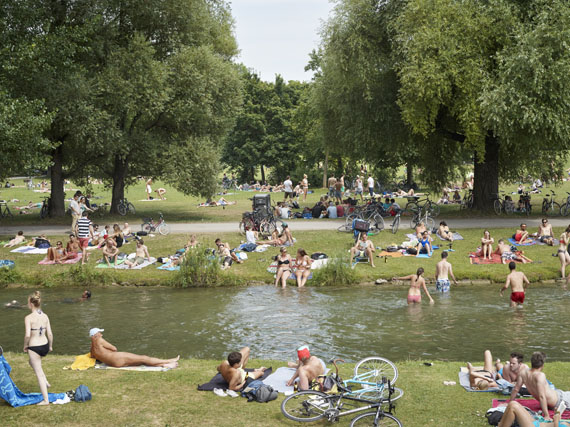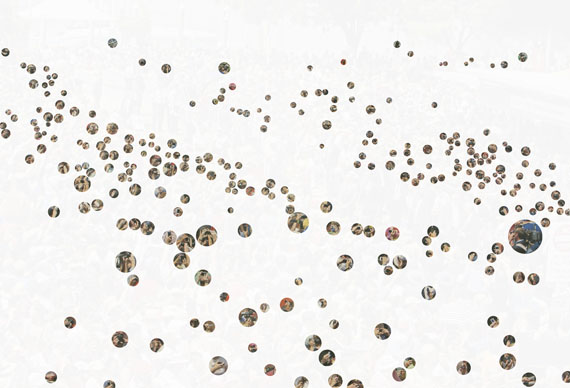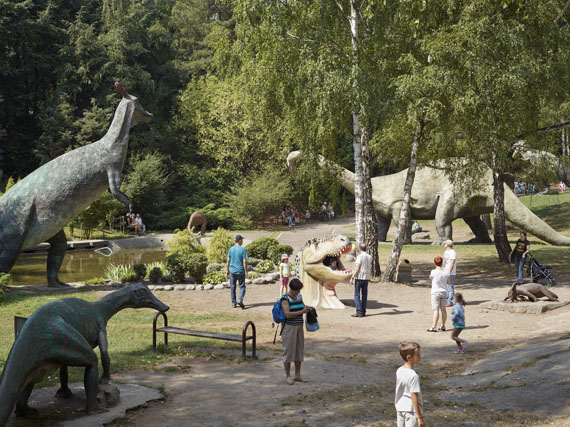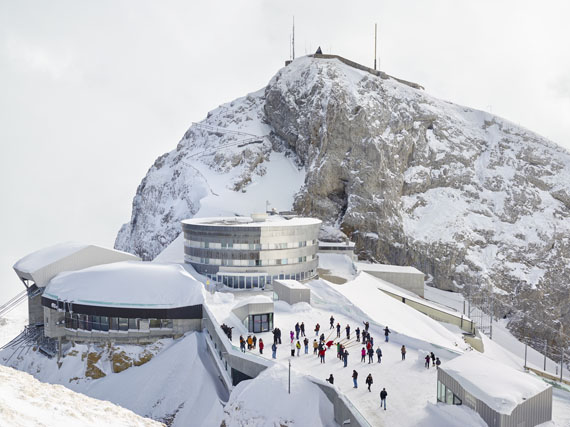
Simon Roberts »
Public Performance
Exhibition: 27 May – 31 Jul 2017
Fri 26 May 19:00

Robert Morat Galerie
Linienstr. 107
10115 Berlin
+49 (0)30-25209358
info@robertmorat.de
www.robertmorat.de
Thu-Sat 12-18 +

Simon Roberts
"Public Performance"
Exhibition: 27 May – 31 July, 2017
Opening Reception: Friday, 26 May, 7pm
Robert Morat Gallery is thrilled to be able to show new work by Simon Roberts this summer. "Public Performance" assembles works from three different series by the British photographer.
"Urban Parks – Green Lungs of the City" (2015–2016)
Until the mid 1600s urban parks were private; the exclusive domain of wealthy families and royalty. By the mid 1800s urban parks were starting to be seen as a way to serve the public and later as a remedy to social ills caused by the Industrial Revolution and overcrowding in lower-income neighbourhoods. Today urban parks are increasingly being created from reclaimed lands in and around cities. This photographic narrative offers a timeline of urban parks beginning in 1660, when St. James’ Park in London was made available to the public, up to the present day. It illustrates the evolving nature of urban parks over time and the philosophies behind them, reflecting the cultural history and role they play as places of social encounter and of self-staging in public space – predecessing today’s social media networks.
"Sight Sacralization: (Re)framing Switzerland" (2016)
When wealthy Euopeans set off on their Grand Tour of the continent in the 1800s, they expected Switzerland to inspire them with vistas of sublime grandeur. The landscape’s untamed romanticism was a crucial component of Switzerland’s national identity and cultural prestige. Today, the Swiss landscape often resembles a theater set, where tourists are transported to officially designated areas of natural beauty to gaze upon epic views from the safety of stage-managed viewpoints. This process is referred to by the American scholar Dean MacCannell as "sight sacralization": a place is named, then framed and elevated, before being enshrined, mechanically reproduced and finally socially reproduced across a variety of media. Tourists are both performers and spectators, part of the circle of representation in which “all we see is seen through the kaleidoscope of all that we have seen before” (Andy Grundberg). These large-format tableaux photographs are taken of viewing platforms at some of the most photographed places in Switzerland. The locations were sourced using the online mapping software Sightsmap that creates popularity heatmaps based on crowdsourcing geo-tagged photographs uploaded to the Internet. The work raises questions relating to aesthetics, performance, and individual and collective identities. This series was commissioned by Fotostiftung Schweiz and Musée de l’Elysée in Lausanne, where it will be on show October 25 to January 7, 2018.
"The Last Moment (2011–2014)"
In "The Last Moment" Simon Roberts uses techniques of scanning, layering, marking and masking to create stripped-back, abstract images in which circles of various sizes float free in semi-transparent skies. Much has been written about the huge number of photographs being produced daily on a global scale, of the changing role of the photographer and the constant need to document our lives and the world around us. It is within this social, technological and psychological context that Roberts produced this series of work. In a first step he scanned photographs of key world events that he had collected from British broadsheet newspapers. The act of scanning the entire surface of the printed newspaper is a physical gesture and is followed by an act of mark making: every occasion in which someone is using a camera, whether a pocket-sized phone camera or a professional digital SLR, is noted and then circled, so that only the device is visible. The idea of transluscense, especially as it relates to optics and lenses, is central to the work. Roberts masks off the background, but not entirely, using a white layer to create a ghostly veneer – a negative space – patterned by different constellations of artificial disembodied ‘eyes’. Translucidity is not only a visual aesthetic running through "The Last Moment" but a metaphor for the various ways cameras function and are used in today’s societies.
SIMON ROBERTS, born 1974, studied Human Geography and Photography in Sheffield. He gained international reputation with the publication of his books "Motherland" (2007), "We English" (2009) and "Pierdom" (2013). His work has been awarded and exhibited internationally, among others at the Museum of Contemporary Photography in Chicago, the Museum of Contemporary Art in Shanghai, at Fotostiftung der Schweiz in Winterthur, and at the National Media Museum in Bradford, England. His work is found in important collections such as the Deutsche Börse Art Collection, the George Eastman House, and the Wilson Centre for Photography. Simon Roberts lives and works in Brighton.�

Simon Roberts
"Public Performance"
Ausstellung: 27. Mai bis 31. Juli 2017
Eröffnung: Freitag, 26. Mai, 19 Uhr
Die Robert Morat Galerie freut sich sehr, in diesem Sommer neue Arbeiten von Simon Roberts ausstellen zu können. Die Ausstellung "Public Performance" versammelt Arbeiten aus drei unterschiedlichen Serien des britischen Fotografen.
"Urban Parks – Green Lungs of the City (2015–2016)"
Bis in die Mitte des 17. Jahrhunderts waren innerstädtische Parks in Europa im Privatbesitz wohlhabender Familien und des Adels. Erst seit der Mitte des 19. Jahrhunderts werden öffentliche Grünanlagen als städtische Erholungsgebiete betrachtet und angelegt, als "grüne Lungen", die der Bevölkerung Erleichterung verschaffen in den durch die Verwerfungen der industriellen Revolution zum Teil unerträglich überbevölkerten Arbeiterquartieren der europäischen Großstädte. Heute, wo die urbane Planung in den europäischen Innenstädten oft abgeschlossen ist, entstehen neue Parks immer häufer auf zurück gewonnenen Brachflächen in und um die Städte herum. Simon Roberts’ fotografische Serie verfolgt eine "Timeline" entlang der Geschichte städtischer Parks - von 1660, als in London der St. James Park der Bevölkerung zugänglich gemacht wurde, bis heute. Die Serie zeigt die sich verändernden Bedeutungen der Parks im Stadtraum im Laufe der Jahrhunderte, ihre kulturhistorische Geschichte und ihre Rolle als Ort der Begegnung und der Selbstdarstellung im öffentlichen Raum – als Vorläufer sozialer Datennetzwerke sozusagen.
"Sight Sacralization: (Re)framing Switzerland" (2016)
Wenn wohlhabende Europäer im 19. Jahrhundert auf ihre große Europa-Rundreise aufbrachen, erwarteten sie von der Schweiz überwältigende, die Seele erhebende Landschaftsansichten. Die ungebändigte, romantische, majestätische Natur wurde zum Kern der helvetischen Identität und zu ihrem kulturellen Prestige. Heute erscheint die Landschaft der Schweiz oft wie ein Bühnenbild. Touristen werden an offiziell ausgewiesene Orte von zertifizierter landschaftlicher Schönheit geschafft um dort von TÜV-geprüften, abgesicherten Aussichtsplattformen aus ikonenhafte Naturansichten zu betrachten. Der amerikanische Kulturforscher Dean MacCannel bezeichnet das als "Sakrifizierung des Anblicks" (Sight Sacralization): Ein Ort wird benannt, eingerahmt und erhöht, bevor er quasi als Heiligtum verehrt, mechanisch reproduziert und schließlich durch eine Vielzahl von sozialen Medien reproduziert wird. Touristen werden sowohl zu Darstellern als auch zu Zuschauern in einem Kreis der Betrachtung, in dem, laut Andy Grundberg, "alles was wir sehen durch das Kaleidoskop der Dinge betrachtet wird, die wir zuvor gesehen haben!". Die großformatigen Arbeiten in Simon Roberts’ Serie wurden von den Aussichtsplattformen an den meistfotografierten Orten der Schweiz aufgenommen. Diese Orte wurden durch die Software Sightsmap identifiziert, die anhand der geo-tags von im Internet verbreiteten Bildern eine Echtzeit-Heatmap erstellt. Die Serie beschäftigt sich mit Fragen nach Ästhetik, Darstellung und individueller und kollektiver Identität. Das Fotoprojekt entstand im Auftrag der Fotostiftung der Schweiz und des Musée de l’Elysée in Lausanne, wo es vom 25. Oktober bis zum 7. Januar 2018 zu sehen sein wird.
The Last Moment (2011–2014)
Für seine Serie "The Last Moment" nutzt Simon Roberts Scans, Überlagerungen, Markierungen und Ausblendungen, um auf das Wesentliche reduzierte, abstrakte Bilder zu schaffen, in denen unterschiedlich große Kreise scheinbar schwerelos in halb-transparenten Himmeln schweben. Es ist viel die Rede von der enormen Zahl von fotografischen Bildern, die heute täglich weltweit entstehen, von der sich verändernden Rolle des Fotografen und von dem andauernden Bedürfnis, unser eigenes Leben und die Welt um uns herum zu dokumentieren. Vor diesem sozialen, technologischen und psychologischen Hintergrund entstand Simon Roberts’ Arbeit. In einem ersten Schritt scannt er Bilder von globalen Ereignissen, die er in britischen Tageszeitungen gefunden hat. Das Scannen einer ganzen Zeitungsseite ist ein körperlicher Akt, dem ein Akt des Markierens folgt: Jedes Mal, wenn auf den Fotos eine Kamera zu sehen ist, sei es eine Handy-Kamera oder eine professionelle digitale Spiegelreflexkamera, wird diese markiert und eingekreist. Der Begriff Transluzenz, also Lichtdurchlässigkeit, wird zum Schlüsselbegriff der Serie, wenn Roberts in einem weiteren Schritt den Hintergrund ausblendet, indem er ihn mit einer weißen Schicht überlagert, die eine gespenstische Blende erzeugt, einen Negativraum, markiert durch unterschiedliche Konstellationen von körperlosen "Augen". "Transluzenz" soll in diesem Projekt aber nicht nur als Prinzip der visuellen Gestaltung verstanden werden, sondern auch als Metapher für die Rolle, die Kameras und die Fotografie in unseren Gesellschaften heute spielen.
SIMON ROBERTS, geboren 1974, studierte Kulturgeschichte und Photographie an der Sheffield University und fand internationale Beachtung mit der Veröffentlichung seiner Publikationen "Motherland" (2007), "We English" (2009) und "Pierdom" (2013). Seine Arbeit wurde bereits international ausgezeichnet und ausgestellt, unter anderem im Museum of Contemporary Photography in Chicago, dem Museum of Contemporary Art in Shanghai, der Fotostiftung der Schweiz in Winterthur und im National Media Museum in Bradford, England. Arbeiten von Simon Roberts finden sich in wichtigen Sammlungen wie der Deutsche Börse Art Collection, dem George Eastman House und dem Wilson Centre for Photography. Simon Roberts lebt und arbeitet in Brighton.�

